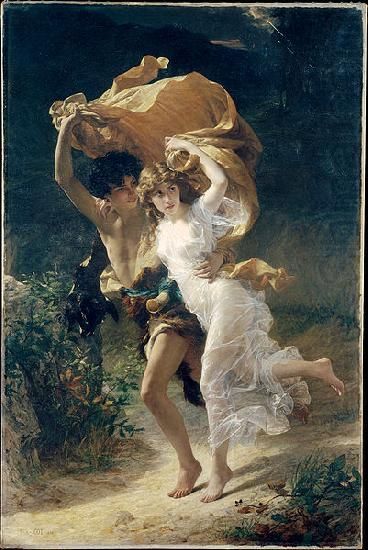Art is in a condition of Ultra Free-Range. Perhaps it’s evolution; perhaps it’s just a fashion cycle.
The former kingpins of art, Representationalism (which I prefer to call, more accurately, Illusionism) and Meaningful Content began to crumble during the end of the nineteenth century, and were wiped away by the cognoscenti of the twentieth.
Well, we’re done with that now. The twentieth century is over. 1984, the year we anticipated with dread, is long over and 2001 turned out nothing like the movie.
The former kingpins of art, Representationalism (which I prefer to call, more accurately, Illusionism) and Meaningful Content began to crumble during the end of the nineteenth century, and were wiped away by the cognoscenti of the twentieth.
Well, we’re done with that now. The twentieth century is over. 1984, the year we anticipated with dread, is long over and 2001 turned out nothing like the movie.
 The Storm, Pierre Auguste Cot
The Storm, Pierre Auguste Cot When I was a kid my stepmother subscribed to a series of educational art folios. The introductory issue featured a reproduction of The Storm painted by Pierre Auguste Cot in 1880, and boy did that folio author tear that painting to shreds. During my college years I went to the Metropolitan Museum of Art in New York City dozens of times and though The Storm is in the Met’s collection, I never saw it. Last year on my first visit to the Museum in decades, I found The Storm in a position of honor.
So we’re no longer constrained to paint in any particular mode, nor to react against any particular canon.
Today everything is allowed, from the abstract non-objective to the romantic, and though I am personally very happy about that, I find myself in a meta-aesthetic bind. Knowledgeable friends encourage me to take my art in this or that direction. Many point out “errors” that I committed not for error’s sake, but for an expressive reason. I prefer to continue in my chosen path. Some call me contrarian for that.
Comes to mind a brief conversation with Russell Richardson, a former colleague whom I greatly admire. After a meeting during which I remained characteristically silent I confided to him that it troubled me to be so frequently the only one in the room holding a completely divergent opinion. He generously told me that my ideas were valuable to the group and I should voice them; and I, aware that I would just be shouted down, said, “Yes, but it’s not much fun for the person expressing that lonely point of view.”
I need to sit down in front of paintings and really hash it out with someone whose opinions and insights are close enough to mine that we don’t need to spend a lot of time finding common ground. No wonder successful artists so often come in pairs.
So we’re no longer constrained to paint in any particular mode, nor to react against any particular canon.
Today everything is allowed, from the abstract non-objective to the romantic, and though I am personally very happy about that, I find myself in a meta-aesthetic bind. Knowledgeable friends encourage me to take my art in this or that direction. Many point out “errors” that I committed not for error’s sake, but for an expressive reason. I prefer to continue in my chosen path. Some call me contrarian for that.
Comes to mind a brief conversation with Russell Richardson, a former colleague whom I greatly admire. After a meeting during which I remained characteristically silent I confided to him that it troubled me to be so frequently the only one in the room holding a completely divergent opinion. He generously told me that my ideas were valuable to the group and I should voice them; and I, aware that I would just be shouted down, said, “Yes, but it’s not much fun for the person expressing that lonely point of view.”
I need to sit down in front of paintings and really hash it out with someone whose opinions and insights are close enough to mine that we don’t need to spend a lot of time finding common ground. No wonder successful artists so often come in pairs.
 RSS Feed
RSS Feed